
I am very excited to introduce the first issue of Quarter Up, an online newsletter dedicated to pinball and vintage arcade gaming. Each issue will feature articles on the history of particular games or companies, interviews with people in the industry, and musings on the places where pinball and life intersect.
Quarter Up is built on Nantucket E-Books, which uses simple design fundamentals and freedom-loving software to deliver the best possible reading experience on phones, tablets, and PCs.
Our first issue represents a lot of hard work from journalists, authors, and artists across the country. If you have a question or comment for one of us, please send an email to njb@nantucket
So, enjoy Quarter Up, a newsletter for those who play the silver ball.
Nicholas Bernhard
Editor.
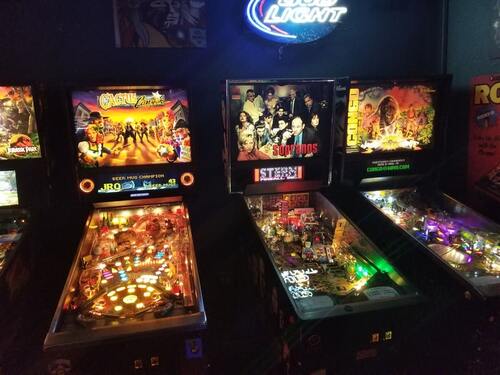
In the purely visual, pinball stands alone as a medium. Even those unfamiliar with the game and its mechanics can identify a machine’s features at a glance.
A plunger, flippers, bumpers, and ramps act as the core, further enhanced with stunning artwork, flashing lights, elaborately engineered contraptions, and even LED screens with minigames of their own. While these components are all considered standard in modern pinball, their development occurred gradually. In order to better understand the mechanics that define pinball as a medium, one need only take a tour through the eras of pinball.
Though technically not pinball, bagatelle tables developed the first major mechanic of the game, the plunger. Bagatelle, a European pub game, operated similarly to billiards, but with a sloped board, wooden pins, and scored holes that players shot for. Though this game relied more upon luck than skill, hitting the ball with a cue at varying strengths gave players a sense of agency. This control over striking the ball transferred over to a more compact version of a bagatelle table invented in 1871. The plunger was a spring-powered implement the player would pull back to strike the ball, filling the role of the cue. To match the scale of this miniature bagatelle, the ball was shrunk to the size of a marble, becoming the first pinball.
In 1931, a company by the name of Bally released Baffle Ball, the first proper coin-operated pinball machine. Though similar to the miniature bagatalle tables that existed prior, it coined the name and put the playfield behind a pane of glass. Bumper, also developed by Bally, was actually the second pinball game to implement bumpers, after lifting the idea from Bolo, a game released by Pacent Novelty in 1936. A natural extension of bagatelle’s wooden pins, bumpers served as another obstacle for the player to account for, while also extending the game’s play time by bouncing the ball around unpredictably. Bally also introduced the first proper score counter, a convention that persists to this day.
Humpty Dumpty, developed by Harry Mabs of Gottlieb in 1947, was the first to implement electromechanical flippers. As another tool for player control alongside the plunger, flippers truly defined pinball as its own unique style of game. With its newfound popularity, several companies stepped into the pinball arena, including Gottlieb, Williams, and Bally.
Ramps were introduced in 1953’s Nine Sisters by Williams, multiball in 1956’s Balls-A-Poppin by Bally, and in 1960, Williams added the first moving target in Magic Clock.

By 1975, electromechanical and gas-powered parts were well established in pinball, and computers were the next logical step. Spirit of 76 by Micro Games was the first solid state pinball machine. While not radically different from prior games, the underlying shift away from electromechanical parts made the design of new machines more flexible. Keeping track of the score and complex objectives became trivial. Machines themed around movies and other licenses were on the rise, and these benefitted from more complex and abstract avenues of gameplay. The first of these was Wizard! by Bally in 1975, establishing a convention of tie-ins which became a hallmark of pinball. Sound became a factor in pinball with Williams’ Gorgar in 1976, the first game to feature speech samples. Later games introduced music and more sophisticated sounds, solidifying pinball as a canvas for representing nearly any form of media.
Dot-matrix and Pinball 2000 were the two major advancements of this decade. One set the standard for modern pinball, and the other factored into an industry crash.
Dot-matrix replaced the simpler score displays of previous years after their introduction in 1991 with Data-East’s Checkpoint. These displays allowed for animation and even small-scale games to occur in the background of a pinball game.

The 1990’s saw the release of some of the most popular games of all time: The Addams Family (Midway, 1992), Attack From Mars (Bally, 1995), and Medieval Madness (Williams, 1997), just to name a few. Williams developed Pinball 2000, an experimental design with an integrated video screen on the playfield. Only two games were ever developed for this technology: Revenge From Mars and Star Wars Episode I. While embracing new technology, these titles compromised the deep gameplay of previous machines. The lukewarm reception to Pinball 2000 resulted in Williams’ departure from the industry. With Data-East acquired by Sega in 1994, and Gottlieb closed in 1996, pinball giants were dropping and the industry crashed at the end of the 20th century.
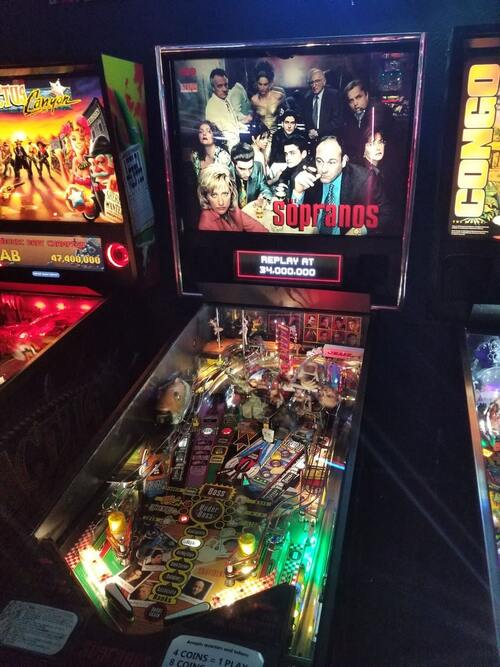
Pinball reached an all-time low. Though there was little innovation in this time period, a few sparks of progress foreshadowed the upcoming renaissance. In 2002, Virtual Pinball was showcased as a prototype for a fully digital machine, and the concept was developed by UltraCade into 2006’s UltraPin. These advancements were a sign of pinball’s future direction.
The first pinball machine to be commercially released with an LCD display was Jersey Jack Pinball, Inc.’s The Wizard of Oz. Though similar to the dot-matrix displays of the 1990s, LCD displays allowed for further advancements in graphics, even those integrated into the playfield itself. Later, Stern Pinball, Inc. incorporated this technology into their own machines. The combination of new technology and a major resurgence of production reinvigorated interest in pinball among the public. Stern dominated the market and released machines that pushed pinball to its limits. With deep, objective-based gameplay and state-of-the-art visuals, pinball entered its renaissance with the game at its most complex and multifaceted.
From a miniature scale replica of bagatelle, pinball evolved into a multi-media spectacle that appeals to casual and hardcore players alike. With the origin of pinball and its mechanics in the past, one can only wonder what lies in its future.
Pinball is a form of arcade gaming with nearly ninety years of history. With all of those decades and games stacking up over time, it can be intimidating for newcomers to jump in and slam the silver ball. But fear not! Here are…
After reading Miller’s article on the various eras, you should now have a basic understanding of pinball history. Let’s take a deeper look at the tables themselves. Okay, you put your quarter in the machine, how do you launch the ball? With the plunger, of course! This mechanism is sometimes spring-loaded, sometimes trigger-loaded and other times it’s a button, but once you pop that sucker, your ball is in play!
If you launched your ball with the right amount of force, you might have triggered a skill shot. This is a special bonus that you can only get once per round at the start of a round. Now that the round has begun, you’re either competing for a high score or are trying to clear objectives on the table. Whatever the case, you’ll need to keep the ball afloat. You’ll do that by manipulating the flippers. Usually located at the bottom of the table, the flippers are controlled by a trigger on the left and one on the right. A common setup is to have two flippers close to the player, but some games have more than two. Sometimes a 3rd flipper or even a mini-playfield (Black Hole, Family Guy). All left flippers are controlled by the left trigger, all right flippers are controlled by the right trigger.
The flippers are almost like goalies for the drain. You don’t want your ball to fall through there, or else you’ll lose a chance (“drain”, “drains” or “drained”). Most pinball games before the ’70’s offered five balls, or chances, essentially the pinball equivalent of lives in video games. Most modern games offer three with the possibility of earning one or two extra balls per game session. Some players will call games they deem unfair or having some cruel drains “drain monsters” or “drain-o-matics”. Many modern games have timed ball savers (sometimes called “autosave”) that will safeguard novice players from premature drains. Some are more lenient than others.
Commonly, above the flippers are two triangle-shaped rubber parts called “slingshots”, or “slings” for short. The ball will collide with these slings and ricochet off of them. Be careful! They can save you in a pinch or hinder you!
Like the lanes on a highway, there are many different types of lanes on a pinball table. The ones that feed directly into the flippers are called the “inlanes”. Parallel to them on the outer extremities are the “outlanes”. Because they’re so close to the edge of oblivion, these areas can be very dangerous. For example, Twilight Zone is a game known for its nerve-wracking outlanes. Some games like High Speed II: The Getaway, White Water, and No Good Gofers have a launch mechanism called a kickback that can protect you from drains.
There are often several different objects to hit on a playfield. A classic prop is the jet bumper (also called a “pop bumper”). These are piston-like protrusions, usually in clustered groups of three. If a game tells you to “shoot the jets”, aim for these guys. Most games from the Solid State era and beyond have colorful proprietary props called “playfield toys” (commonly shortened down to “toys”). Some are there for decorative purposes. Other toys, like the Ringmaster in Cirqus Voltaire, have an impact on game objectives.
Well, you lost your ball. Too bad. It’s time to collect your End-of-ball bonus. This is a score that only gets calculated at the end of a round. Sometimes it can make the difference between a high score or an extra ball.
Lost all of your balls? If you’re lucky, you might win the Match Game. If your randomly selected number matches the one the machine has chosen, you can win a free game (or a replay). Many older pinball games offer a replay if you get a high enough score. When you win a replay, the pinball machine will make a sound similar to a baseball hitting a bat.
There’s plenty more to learn on your pinball journey, but you now might be able to hold a conversation with a pinhead, a pinball enthusiast. Happy ballin’, everyone!
The year is 1984. A time when arcades ruled, and bottles filled with quarters were a common sight among the neighborhood kids. Games were short, sweet, and hardcore. Arcades were meant to take as many of those quarters as possible, while providing as much fun per run as possible.
One of the heavy hitters at the time, was none other than Marble Madness, a game designed by Mark Cerny, programmed by Bob Flanagan, and published by Atari.
The concept of Marble Madness was simple: Use a trackball controller to guide a small marble through an obstacle course, while avoiding traps, enemies, and pitfalls. This was easier said than done, as the stages were filled with instant death traps; falling off the stage was common. This game was a sneaky one, showing its true colors after a deceptively simple first stage. If your first thought was, “Play slowly until mastered,” then the time limit may have something to say about that.
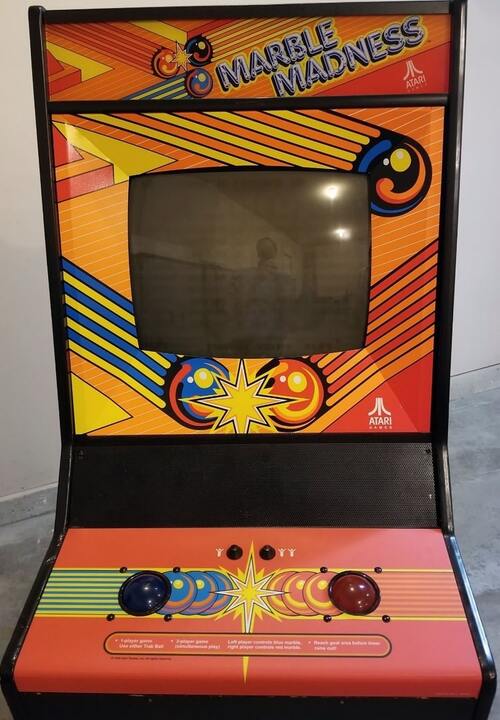
The high level of challenge in Marble Madness got players coming back for more. Its challenge, distinctive presentation, and gameplay mechanics all helped cemented its popularity. Marble Madness would become one of the greatest arcade games ever made, earning a place in the Guinness World Records for its technical and cultural impact.
Atari had a hit on their hands, and they knew it. A sequel was a must. Flanagan started working on a game that would be bigger, better, and longer. He pondered what made Marble Madness such a success, and concluded that appealing to a younger audience could replicate that success.
Thus, Marble Man was born.
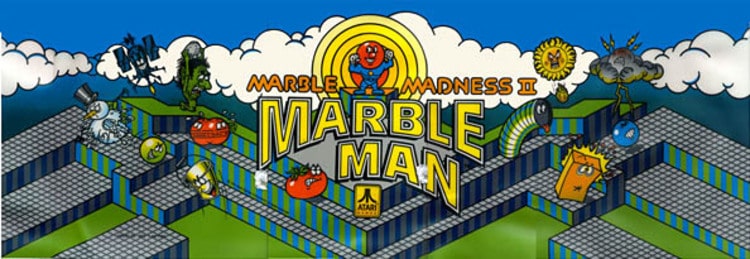
With a new mascot in place, development began. This was going to be Marble Madness on steroids: seventeen levels, power-ups such as cloaking, helicopter, and crusher, pinball bonus levels, and even little quips from Marble Man himself.
It seemed like a slam dunk—yet it didn’t go as planned. Internal focus groups did not care for the game, and an external location test did not go well either. Atari would come to blame it on the trackball controls, as it shows in their internal document Changes to Marble Madness II:
“From the Focus we learned that the trakball is the more intuitive control to roll a marble, and that it is the desired control for the high-end player. But, the joystick was perceived as an easier control for a beginner to learn the game. Thus, we would like to change the trakball control to a joystick, and see if we gain a wider audience. In order to gain the variable speed of the trakball control we need to add a “turbo” button with the joystick. From in-house play and the Focus, the “turbo” was seen as a fun new feature.”
Atari
Players also appeared to have a problem with the character of Marble Man, finding him to be silly and unnecessary Footage by Mylstar Electronics. Another issue was the realism of screams and fall grunts:
“There was no objection to the “cuteness” level of the game from the Focus. But the players did feel the transformation to Marble Man was “hokey, ”stupid,“ and meaningless. We will remove ”Marble Man“ from the entire game. This means the Title screen, cabinet artwork, pinball spell outs, and goal transformation all need to be changed. There were objections to the ”scream“ of acid death, and the fall grunt from the marble. We would like to change these voices to something more comical rather than realistic.”
Atari
With these and several other changes in mind, a second version of Marble Madness II was made.

This second version had any and all references to Marble Man taken off, and the control scheme was switched from a trackball to a joystick. The details on this second prototype are a bit murkier, but it’s well-known that players did not care for it either.
Rather than continuing development, Atari decided that it was best to scrap the project.
This would have been the end of our story, but fans of the original game would not stay idle. Over the years, several collectors were able to obtain complete cabinets, or assemble one from parts. The game would even become available to the public during Arcade events and retro gaming shows.
On May 21st, 2022, a dump of the Marble Madness II PCB started to circulate online through archive.org. It didn’t take long for MAME developers to get the game running on in the emulator. So far, the identity of whoever dumped the ROM is unknown. David Haywood, a long-time MAME contributor said the following in an interview with Ars Technica:
“I think the most likely explanation is the simplest: a PCB turned up, the owner dumped the ROM data from it and put it on The Internet Archive, not wanting the attention it would bring with a more public announcement,“ Haywood continued. ”PCBs of unreleased and thought-to-be-lost [arcade] games show up all the time—the count is almost double digits this year already—even if none are quite as high-profile as Marble Madness II.”
The story of Marble Madness II, and its eventual leak, speaks volumes about the fickle nature of video game audiences. One day, a game could be the king of the hill, then be forgotten and shelved for decades, only to come back up again thirty years later to a warm welcome from old and new players alike. It’s like an old friend who left after high school and then calls you decades later; you meet up and hit it off as if not a day had gone by. That friendship is now rekindled, and Marble Madness II is now preserved for the future.
Quarter Up reached out to Tim Arnold, owner of the Pinball Hall of Fame in Las Vegas, Nevada. We asked him to name ten machines that were fundamental to the history of pinball, and give us his reasons. Enjoy! — Ed.
#1 Chicago Coin Knickerbocker (1934)
The first game made in the iconic Chicago Coin-Gottlieb factory on Diversey. Game number one on the Chicago Coin model numbering scheme, parts of which are still in use today by Stern. It represented a huge leap by Wolburg and Gensberg, going from just selling machines made by others to setting up a factory and becoming a manufacturer.
#2 Gottlieb Slugger (1938)
The first Gottlieb machine that was the size and shape of what would make this factory famous, five ball novelty machines with no payout. The classic shape, size of backglass, wooden trim, and play-only-for-score all started with this one.
#3 Gottlieb New Daily Races (1947)
Every history of Gottlieb makes much of the well-publicized fight between Bally and their gambling machine cohorts, and pure-as-the-driven-snow D. Gottlieb, champion of non-gambling, non-bingo, five-ball machines. But Gottlieb did build this payout machine in small quantities between 1947 and December 31st, 1951, when it became a felony to ship gambling machines across state lines.
#4 Gottlieb Niagara (1951)
At last! Flippers together facing inwards at the bottom of the playfield. After many years of trying them in many other configurations, here is the first time D. Gottlieb got it right. A leap forward towards skill and away from luck!
#5 Bally Balls a Poppin (1956)
This one was rerun as Circus in 1958. Such a great playing game! Fast, noisy, and up to nine balls on the field at once. Why did it take twenty years before the industry went back to multiball excitement again?
#6 Bally Bonus-7 or Super-7 (1970)
Magic Screen fans will never consider that a Mystic Lines bingo can be a lot of fun, and offer more, and larger payouts. There are many side games, like Sunny Circles and extra stuff to buy beyond just extra balls. The Shoot 7 feature is a chance at double or nothing if your first and second ball total adds up to exactly seven! The absolute height of what electro-mechanical logic could do.
#7 Allied Sea Hunt (1972)
This one was rerun as Spooksville in 1973. I have always had a soft spot in my heart for this machine. I played it as a kid, when it ran, which was not often, and got a kick out of a new kinetic experience. A good game to take out your youthful aggression on the shaker handles.
#8 Gottlieb Ready… Aim… Fire (1983)
How could a game that was originally designed as another whole different theme, released at the bottom of one of the worst sales crashes in Amusement Game history, coming from a factory with design and quality control problems, come together to be such a crazy fun machine to play? Hard to find these days because it was the lowest production machine of the ’80’s for Gottlieb. The bouncy simple sound and music they patched in at the last minute are a real ear worm, and when added to the colorful and bright graphics make this game a treat!
#9 Midway Pinball Circus (1994)
Words can not describe this machine, even in its crude prototype state. You have to play it, then imagine what could have been if a finished version had been produced.
#10 Rock-ola World’s Fair Jigsaw (1933)
We have one of these on the floor at the museum, and I always steer newbies to this machine and then stand back and watch them really enjoy the simplest of amusements. Pinheads all debate which of the classic early ’30’s Rock-ola games are the best: World Series, Jigsaw, or Army-Navy. I would have to pick this one.
Tim Arnold runs the Pinball Hall of Fame in Las Vegas, Nevada. It is open for free from 10 AM to 9 PM, except for Friday and Saturday until 10 PM. For more information, visit pinballmuseum.org.
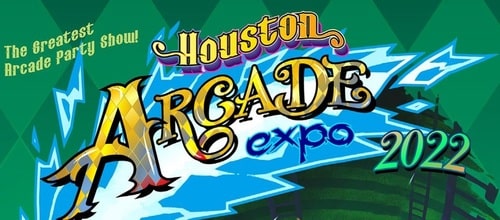
The following is a paid promotion for the Houston Arcade Expo 2022, which will run from November 11th to November 13th. It was written by AT Gonzalez.
Face front, Houston gamers: Houston Arcade Expo 2022 has been confirmed! The show, run by Houston Area Arcade Group (HAAG) will be returning for its 20th year at the Marriott Westchase in Houston, Texas.
Houston game collectors and other journeymen enthusiasts will be providing arcade cabinets, pinball tables, simulators, home consoles, and vintage computers for the public to get up close and personal with. At past shows, classic games from Midway, Williams, Namco, Nintendo, Sega, Data East, Capcom, Taito, and other great game makers have been exposed to the masses. Over one hundred pinball games have been formally confirmed, with plenty of slots left to fill!

Stern’s latest pinball games: James Bond 007, based on the Connery era of Bond, and Rush, based on and featuring the music of the classic rock band, will be the focal point of attention. They will appear alongside one of their recent games, Led Zeppelin. Speaking of music-themed games, there will also be a Weird Al’s Museum of Natural Hilarity table from Multimorphic!
Retro World Series returns to the show! This will be their first time back since 2019. The guys will be hosting gaming competition events for several games: an off-beat mix of Super Smash Bros 64, F-Zero X, Super Dodge Ball, Super Punch-Out, Capcom vs. SNK 2, Frog Bog, and Combat. There’s no fee to enter, so give it a shot! Pay attention to the times and days scheduled or else you will be forced to forfeit!
Currently, the following gaming industry guests are committed: Rush game designer John Borg (known for his work at Data East, Sega, and currently Stern), Tim Sexton (software engineer for several Stern games), Paul E. Niemeyer (artist for several Midway games) and Tim Kitzrow (voice performer for several Williams and Midway games such as NBA Jam).
Vendors will be there to fulfill gaming and anime merch demand. There will be live music and DJs to sound up the halls.
Doors open to the public at 12 noon on Friday, November 11th. Day One will last until 2 AM on Saturday, the 13th.
Day Two in the convention building will officially begin at 10 AM on Saturday morning and will last until 2 AM on Sunday morning.
On Saturday, there will be a vendor Swap Meet in the parking lot from 8 AM until12 noon.
Houston Marriot Westchase
2900 Briarpark Dr.
Houston, TX 77042
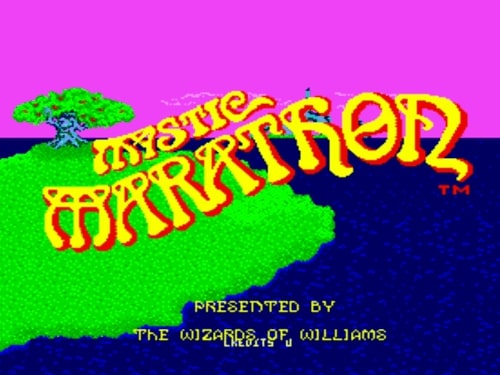
In 1999, some friends and I visited the Grand Prix Race-O-Rama arcade in South Florida. Now since closed and demolished, this smokey and humid amusement center was home to well over one hundred public amusement devices. One cabinet that, by chance, got our attention had strange gold lettering on the marquee, and artwork of whimsical elf-like characters competing in a footrace. The game kicked our asses and consumed a few our tokens. Simply put, it was very hard for us uninitiated peons. My reaction was a resounding “bleh.” I think we walked away after two rounds. The game was called Mystic Marathon.
Despite our initial reaction, Mystic Marathon would occasionally come up in conversations as the years went on. We had to convince ourselves that it wasn’t some shared dream or hallucination or a hoax like Polybius. I guess you could say we were mystified by it.
For a few decades, it had been hard to track down information on Mystic Marathon. As I would later find out, the game wasn’t widely distributed. While doing the occasional late-night Google searches in a haze, not much came up. Aside from the occasional low-resolution picture here and there. Searching for “Mystic Marathon” turned up a lot of dead ends. It didn’t even have a Wikipedia page until 2016. When I saw a cabinet at the 2018 Houston Arcade Expo, it was my first time playing the game in nineteen years. And I later learned that the very cabinet showcased at the Expo was supplied by the man who co-programmed the game!
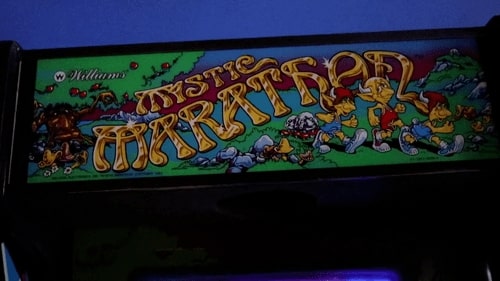
So, what is the deal with Mystic Marathon? It’s a triathlon-themed game where you play as a gnome or elf-like creature called a Benkin (pronounced benny-kin) competing against other Benkins in a yearly competition to keep the peace held on “The Mystic Isles.” Sometimes you race on land, sometimes you’re swimming, other times you’re using a prop like a crow or a balloon or a hole in the ground to get an advantage. This is a game where you can move in eight directions or do a little hop. To carry on to the next round, you must rank third place or higher. Aim for the top because every little thing will try to squash your progress. Once you lose even the tinniest bit of momentum, making progress can be very difficult.
The project was headed by Kristinia Donofrio, who had previously worked on some of Williams’ pinball games and would later go on to do great work at Data East’s pinball division. It seems at the time, Williams was trying to branch out a bit and was willing to entertain some more experimental ideas. They had success with fast-paced action games like Defender, Robotron, and Joust, and around they wanted to develop games that didn’t showcase direct violence, like their quirky action game Bubbles. Characters in Mystic Marathon do not get hurt or killed, they simply get impeded by the obstacles in the game.
My video game journeys led me to one of the programmers on the game: the late Ken Graham. Graham had done some last-minute debugging on Bubbles and Sinistar, and written AI routines for those games. He had also written proprietary software that was used in the development of Williams games like Star Rider and Splat. On many occasions, Ken said he believed Mystic Marathon was the first game produced, designed, and programmed by a woman.
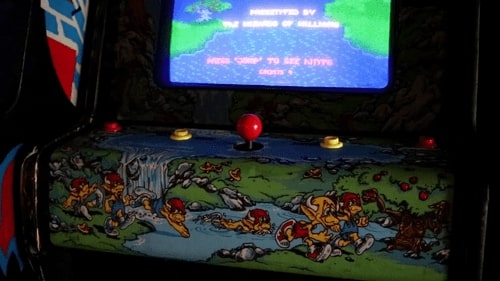
Pam Erickson was assigned to do the cabinet artwork. Erickson had illustrated Williams pinball games like Fire! and Sorcerer. Janice Woldenberg-Miller (a.k.a. Jan Hendricks) was one of the sprite artists on Joust and was assigned to help draw the sprites. Jill Chittenden, who had previously worked on the obscure dual-stick shooter Splat!, also helped with the sprites, or video art. Noah Falstein and Python Anghelo pitched concepts, such as the magic-themed premise, and enemies like Rolling Rock, the Fins, and the Apple-Throwing Tree, but were not part of the dedicated team. John Newcomer, the lead designer for Joust and co-designer of Sinistar, was alluded to on the high score screen, but his contributions are currently unclear.
Development started in late 1982 or early 1983. The game was originally intended to star monkey characters and to be titled Monkey Marathon. Six months into development, after the physics and general build of the game had been locked in, Williams management got some intel that a rival developer was “going to be making a monkey game.” Ken explained to me that at the time, companies like Atari, Williams, and Bally-Midway were hiring private investigators to spy on each other. The suits demanded the Monkey Marathon team change the theme and character sprites within a week, which threw the development team into a panic.
One day, Falstein returned a book he borrowed from Graham, A Spell for Chameleon, the first novel in the Xanth series. Their team members took interest. The Xanth series are fantasy novels about people with magical powers called “Talents” that are largely based on puns. This conversation inspired the team to make a magic-themed game based on puns and fantastical language. For instance, one of the obstacles in the game is a Rolling Rock, like the beer Rolling Rock, or there are Hop Ahead Holes that can give you a horizontal advantage in the race.
The poem on the looping demo (the attract mode) was written by Kristina; it tells the lore of the game:
“Once every year, it is decreed
That those who have the will
For glory, fame and wealth indeed
Shall meet in games of skill.
A marathon will be their test
On mystic isles of lore
And whomsoever proves the best,
More clever, faster than the rest
Will top the greatest score.
To be the greatest you must use
Strong magic if you dare
For on the isles your foes will choose
The magic paths to make you lose
Unless you beat them there.
But dangers lurk on land and seas
To guard the treasures bright.
So while you gather points with ease
Avoid the trolls, the rocks, the trees
Or you will feel their might.
Above all, don’t forget the race
Place third or better, friend
If you let magic slow your pace
Or treasures pull you from the chase
Your marathon will end…”
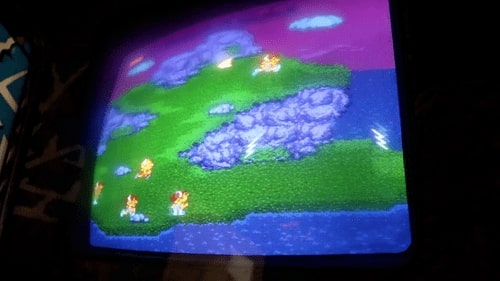
The attract mode was programmed by Ken Graham. The sprite image of the title and the cycling was a routine he created, which was a huge point of pride for him. Mystic Marathon is considered to be one of the first games to show two layers of sixteen colors simultaneously. Ken believed that the title sprite was the largest singular image generated in a video game (for the time, at least).
Kristinia and Ken wrote the game in assembly language, which most Williams video and pinball games were programmed in “… as low level as you can get” as Ken put it. “There was one ROM chip that contained the [Williams] 6809 downloader and debugger. These were hooked up to our VT100 terminals… the VT100s had a serial port to the back that you could stream from the computer. The RAM was loaded directly with our code instead of using EEPROMs. We had a video game cabinet and used a couple of different control panels [from Joust and Robotron.”
Most of the game’s sound effects were recycled telecodes from other Williams pinball and video games, including Tri-Zone, Blackout, Defender, and Joust. The cheering-crowd sound effect was from Black Knight.
Williams liked the game enough to bring it through development but was reluctant about manufacturing the game en masse. They decided to sell Mystic Marathon as a “replacement game”, later known in the industry as a “kit game”. The game would be sold as just the bare board, to replace the hardware in a different arcade cabinet.
The conversion process was not simple pulling out an old board and swapping it with a new one. This was before the JAMMA standards, and the Atari System 1 method of swapping ROMs was introduced. Mystic Marathon ran on totally different hardware from any of the previous Williams games, or licensed games such as Moon Patrol, you’d have to basically dismantle or destroy an older game, assuming the older game hadn’t been ruined already.
Williams produced five hundred conversion kits for Mystic Marathon, but there were a few problems. The game had a lukewarm response during testing, and in some locations, dedicated players were figuring out the game too quickly. In an extreme case, a player was going on for an hour on a single credit. The profitability wasn’t there. Williams sat on Mystic Marathon for six months and did not distribute the game widely until March of 1984. In the meantime, Williams laid off about ninety percent of its software staff and chose to focus primarily on Solid State pinball games again.
In my interactions with Ken, he explained to me that he felt very sentimental toward Mystic Marathon. He conferred that though the game wasn’t popular or successful, it was special to him because he spent more time doing developmental work for it than any of his other Williams games. He helped keep a census on the game. He suggested that probably twenty to thirty remain in working condition as of December, 2021. He encouraged people to give it a try and greatly appreciated its handful of fans.
The Game Preserve in the Woodlands is one place where you can still play Mystic Marathon on original hardware. If you’re in the Houston Area, pay them a visit and look out for it!
I am of ‘old school’ ways and have always played, when and where, pinball. At the Greyhound depot (long gone), Trailways depot (longer gone), arcades, and divey eateries. Nowadays, pinball machines have been replaced by digital video games that do not rely on eye -hand coordination, physics, geometry, and quick reactions. Nor does playing them in any way promote any form of meditation.
We could say that meditation doesn’t have reason. Or doesn’t have a purpose and in this respect it’s unlike almost all other things we do except perhaps making music and dancing. Because when we make music, we don’t do it in order to reach a certain point such as the end of the composition. If that were the purpose of music, to det to the end of the piece, then obviously the fastest palyers would be the best. And so likewise, when we are dancing, we are not aiming to arrive at a particular place on the floor… Meditation is the discovery that the point of life is always arrived at in the immediate moment.
Alan Watts
When one becomes ‘one’ with the ball, every thing that happens is done without any thought or identity; it is a unification of the player to the silver ball. It is this ‘oneness of knowledge’ with the ball and the player, a feeling of being plugged in with the universe that is the Now moment. It is like a sense of satori, momentary enlightenment, an awakening that everything is a part of the All, there is no division between the player and the machine. I know because I have been there more than once.
There is no worry about losing the ball, of how many points are being made, of the time, or anything else. A person may put a coin on the glass to challenge or play next, only to realize that the other is ‘tuned in’ and pick up his coin and leave, knowing that it will be awhile or the player is just too damned good. Oft times the player never even knew that they had been challenged for there is only them, the silver ball, and the machine.
I have played at a drive-in in Arvada, a bowling alley in Nebraska where the machine would not tilt, at Tivoli Gardens in Copenhagen on a familiar machine, the Chicken Diner, bus depots in Modesto, and other localities that allowed me a “Oneness” with the machines, a state of meditation, satori.
The sense of ‘what it is’ is an end point without thought or concern of ‘self’. Just as winning or losing is not ‘what it is’ about; it is neither the goal nor desire, it is just a game.
LYONS CLASSIC PINBALL
399 Main St., Lyons, CO 80540
Fall Season: Thursdays at 7:30 PM, runs through November 17th.
Tournaments on the second Saturday of each month at 3 PM. $10 entry fee, first-timers play free.
Women’s Tournaments on the third Saturday of each month at 3 PM. $5 entry fee, first-timers play free.
RENO PINBALL
600 S. Center St., Reno, NV 89501
“Pin-Brawl” Tournaments every Tuesday. Registration starts at 6 PM, tournament starts at 7 PM. $5 admission, with cash prizes for the top three places.
“Flipper Frenzy” Tournaments on the third Saturday of each month. Registration starts at 12:30 PM, tournament starts at 1 PM. $10 admission, with cash prizes for the top three places.
Thanks for reading the first issue of Quarter Up. If you have any questions or comments about one of these articles, send an email to njb@nantucketebooks.com, and we’ll publish it in the next issue!
Nicholas Bernhard
Nicholas Bernhard is the editor of Quarter Up. He is the developer of the Nantucket E-Books platform, and the Shanty markup language. He may be reached at njb@
A.T. Gonzalez
Originally from Pennsylvania, A.T. Gonzalez began his video game journey as a toddler playing Super NES. This opened up a whole new dimension of artistic expression for him. He began collecting games as a hobby a few years later down the line. His favorite game franchises are Mega Man, Mario, Metroid, Castlevania, F-Zero, Devil May Cry, Metal Gear, and plenty of others!
Currently based in Southeast Texas, he writes, makes short films, does studio photography, voice-over work, and audio production in his spare time.
Miller Burruss
Miller Burruss, or “SaturnPM”, is a writer, streamer, and videographer partnered with Software Agents TV.
Twitter: @SaturnPM
Email: miller.burruss@gmail.com
Carlos Martinez
Carlos Martinez is your friendly neighborhood code monkey. Writes usable code during the day, and tinkers with old game consoles at night. Or snuggles with the wife, mostly the latter.
Buffalo
Born and raised in California 71 years ago, escaped to Cope, Colorado to go retro with a roadside attraction.
Having the only ‘commercial’ pinball within 70+ miles, a silver ball junkie of many decades, I miss the bowling alley and bus stop draw of a pinball machine.
Pinball, the game that promotes eye/hand reaction, reflexes, physics, geometry, and mental stimulation.
Christopher Jacobs
Hello, I’m Christopher Jacobs and I’m primarily a digital artist. I specialize in doing logos, character designs and posters such as the one for Quarter Up which was a pleasure to work on. If you’d like to contact me for work, you can email me at ChrisCrossProSauce@gmail.com.
This issue of Quarter Up is © 2022 Nantucket E-Books, LLC. Copyright for the articles contained in this newsletter is reserved by their respective authors.
Cover art is © 2022 Nantucket E-Books, LLC.
TEXT © Nantucket E-Books LLC for newsletter
DOWNLOAD ENTIRE E-BOOKThis e-reader was developed by Nicholas Bernhard, © 2020 - 2023 Nantucket E-Books™ LLC. Nantucket E-Books™ is built on free software, which means it respects the freedom of the writers and readers using it. For more information, check out the software license page, the Help page, or e-mail me at njb@nan